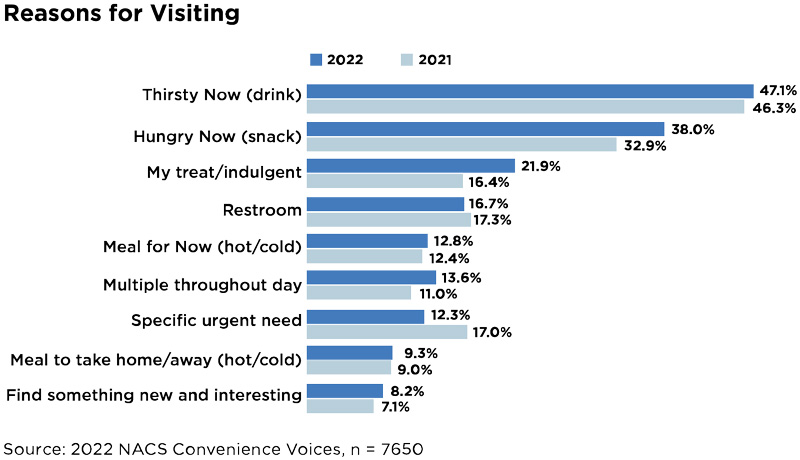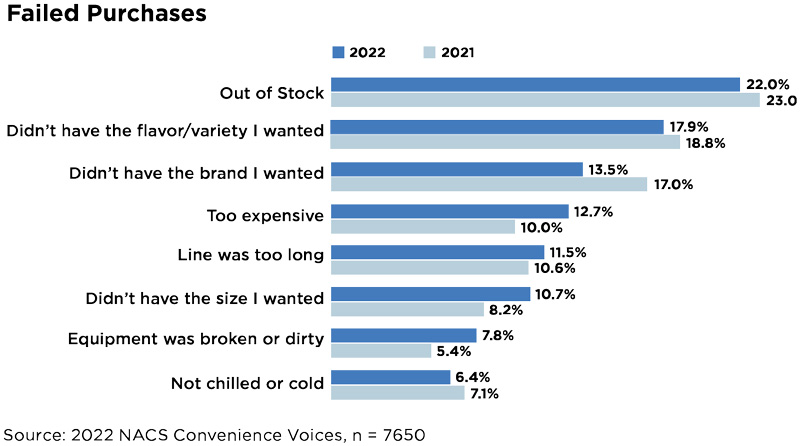The latest insights on shopper behavior, their path to purchase and what they choose to purchase took center stage at the NACS State of the Industry Summit. Highlights from the NACS Convenience Voices program, presented by Leroy Kelsey, NACS director of research, revealed performance benchmarks and customer insights to help retailers and suppliers better understand the convenience shopper’s journey.
“With the convenience retail industry averaging 160 million transactions per day, serving the equivalent of the entire U.S. every two days, the industry has more opportunities than ever to connect with consumers,” said Kelsey. The survey results showed four trends that will shape those opportunities in 2023 and into the future.
Trend No. 1: Remote and Hybrid Continues
The first trend among consumers is the new work model of remote or hybrid working. Brought on by the COVID-19 pandemic, this model of work continues to significantly affect convenience store sales. Trips that could be classified as a classic commuter occasion accounted for approximately one in four trips, or 26% in 2022. That’s down 9 points from the pre-pandemic levels of 34% to 36% (35% in 2019).
Seven out of those nine percentage points occur during the morning daypart (5:00 am to 11:00 am), which has impacted breakfast foodservice sales.
Newly released NACS State of the Industry data for 2022 showed that hot dispensed beverages was the only foodservice category to show sales decline year over year at 0.4%. A direct line could be drawn to the decline in the morning daypart and softness in the hot dispensed category.
Kelsey said that convenience shoppers visited the average convenience chain 2.4 times per week, but when looking at all convenience chains visited, that number expanded to 3.1 trips per shopper per week. He suggested that retailers could take back some of those trips that go to other stores. How? By leaning into the three R’s of retail: relevance, reliability and responsiveness.
Relevance relates to a retailers’ ability to align with their shopper’s needs and interests. Consider the questions “What are we famous for in the eyes of our shopper?” and “How do we spark their interest to inspire more loyalty?” To answer these questions, it’s important to consider how convenience shoppers are evolving.
The 2022 Convenience Voices data showed that more shoppers are looking for increased mobility, with smaller package sizes and meal bridges or snacks to hold them over until their next meal.
Consumers are also shifting from immediate need/urgent purchases to more planning and daily provisioning purchases. They are buying multiple items to consume throughout the day. For example, they might buy a breakfast sandwich and energy drink for now and also buy something for lunch later. Shoppers looking to convenience stores for substantial meals also increased from 23% to 24% year over year.
“People are looking to convenience for food that’s more filling, has more quality ingredients and better taste. They have an option for a snack but are coming for a meal,” said Kelsey.
When asked “Do you plan to buy fast food somewhere else in the next half hour?” 32% of respondents said yes. This represents an opportunity to increase overall sales that can’t be ignored. Allocating resources to capture those customers is worthwhile due to the frequent visits that food can inspire and the high margins that characterize the prepared food category. QSRs are equally trying to reach these customers, because they also recognize the opportunity associated with acquiring additional occasions.
Reliability is built on executing on a consistent basis, which then becomes part of the overall brand promise. Reliability also includes being in stock, having the right assortment and being consistent in service and store conditions, such as cleanliness.
“It’s about the overall experience that’s being delivered, because the customer is at the center of everything we do,” said Kelsey.
Responsiveness is considering the additional products and services a retailer can implement that enhance the overall visit. Seamless checkout, in-store pickup, preordering on a mobile app or offering a loyalty program are not required; however, they can create a point of differentiation and allow retailers to be more responsive to their customers’ needs.
Trend No. 2: More Discerning Shoppers in 2023
The NACS Convenience Voices survey asked 8,000 shoppers, “Was there anything you intended to buy that you didn’t?” Results showed 18% of respondents said there were some items they meant to purchase and did not. Of those shoppers, only three out of the 8,000 reported they would tell staff, indicating a manager would most likely never know that a basket could have had more items.
“Transaction logs will tell us what we sold but they won’t tell us what we failed to sell,” said Kelsey.
Year-over-year supply chain issues have improved along with out of stocks; however, 65% of missed purchase opportunities occurred because shoppers could not connect with a product they sought. Out of stocks are still the lion’s share of those missed opportunities. There’s also been an overall shift towards price sensitivity that comes with inflation and current market conditions. This is something the industry needs to continue to monitor.
Maintaining a clean and efficient store is key to attracting and keeping discerning consumers. Those who didn’t make a purchase because the line was too long rose from 10.6% to 11.5% in 2022. People who noted dirty or broken equipment and didn’t make a purchase increased from 5.4% to 7.8%.
“As we move into the 100 days of summer, our peak driving season, these are metrics that can be shared with your staff to help illustrate the opportunity to increase transactions and basket size. Despite an increase in missed purchases caused by line length, retailers are already working diligently and investing in reducing friction from transactions. Time-saving checkout options are, in part, the reason more consumers are walking through the door and that has tripled to 15% of all shoppers indicating that time-saving checkout options contributed to their site selection over the last five years,” said Kelsey.

Trend No. 3: Exclusive Rewards Leads Digital Engagement
Convenience shoppers on average belong to 6.2 loyalty programs across comparable channels, 2.2 of which are convenience. The convenience industry has engaged shoppers and increased the percentage of shoppers who are convenience loyalty members from 8% to 58% over the past 12 years. Consumers love fuel points as well as coupons, especially during economic uncertainty. Notably, of the top five convenience loyalty features preferred by shoppers, access to exclusive rewards was No. 3 at 32.1%.
“Exclusive rewards are the next evolution of customization. Shoppers are looking at getting more out of every interaction, and they really want digital loyalty to lead that engagement,” explained Kelsey.
Core shoppers indicated they want gamification, sweepstakes, memberships and subscriptions. They want differentiation in terms of how you acknowledge them. They want to find and access locations easily in order to accrue more rewards and redeem existing ones.

Trend No. 4: Emerging Customer Segments
Emerging customer segments was the fourth trend Kelsey shared. Engaging these customers can increase transactions and drive incremental value over time. The 2022 Convenience Voices data showed that EV customers, Gen Z and female shoppers are untapped segments.
The EV Customer
There’s no doubt EVs will be part of the country’s transportation future. Currently 22.2% of non-EV owners are considering buying one within the next two years.
EV owners are more likely to spend more time in the store and generate larger baskets. Convenience Voices data for EV owners shows that 15.5% intended to buy a meal for now (135 index score) and 28.4% were looking for a treat or indulgence item (173 index). Stocking up (11.7%, 198 index) and filling in a few missed items (12.1%, 216 index) were other top reasons.
Fast charging, the number one reason for choosing a location, drew 48% of shoppers to a particular store. Second was “interesting store products” at 45%. Offering engaging products and services ranked higher than the number of chargers as a reason to choose a location.
“If we are going to make changes, we have to get smarter about how to leverage these occasions,” said Kelsey. “People are more interested in how they will fill the time than the number of chargers that are present.”
Younger Demographic
Gen Z shoppers (born 1997 to 2012) are in various stages of economic independence and managing demands that include professional work, travel, car payments and even mortgages. This generation has little or no memory of the world as it existed before smartphones.
Nationally, shoppers using digital search for convenience shopping increased to 23.7% in 2022, up from 16.7% in 2020. Gen Z was No. 1 among consumers, with 28.2% using digital search for a product or service to find a convenience store location.
“To talk to Gen Z, knowing more communication is through the digital experience, we need to understand the language that they will find compelling to get them engaged with store offers,” said Kelsey.
Solving for Gen Z may include offering a range of ethnic cuisines that include menu language such as local, authentic, spicy, farm-raised, plant-based or vegan.
Women Shoppers
The NACS Convenience Voices survey examined the reasons for shopping at a convenience store for female shoppers compared to male shoppers. The findings suggest that the convenience channel has a huge opportunity to enhance existing occasions and build trust with women shoppers.
Refreshment, fuel and meal bridges or snacks stood above male shoppers as the top reasons that women shop convenience. When it came to indulgent treats, women ranked this mission 6 points lower than men, hinting at an opportunity for innovation or offering different products to reach more female shoppers.
Female shoppers are 12 percentage points higher than males in terms of daily provisioning; however, some of the lowest ranked categories for shopping a c-store were meals to take home (7.5%, 85 index compared to males), stocking up (3.6%, 62 index) and fill in a few items (4.2%, 81 index). These occasions are ones that often involve caring for others.
“If you want to sell food and get that permission and trust, you have to have clean restrooms. That ranks 35% higher with females than males,” said Kelsey.